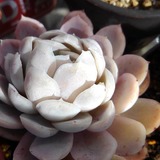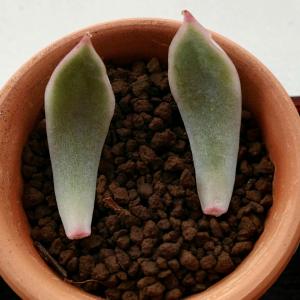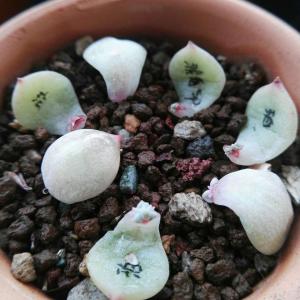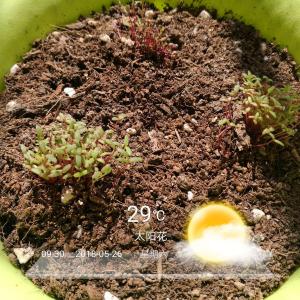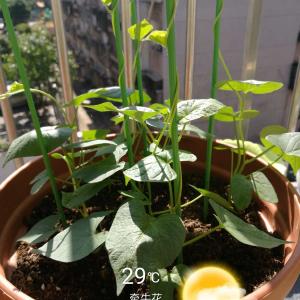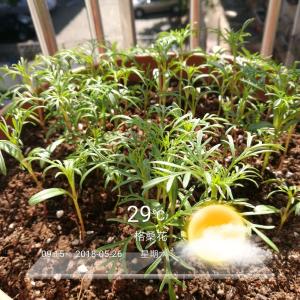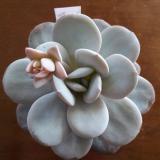文章
Miss Chen
2018年05月26日

Description: This perennial wildflower consists of a small rosette of basal leaves about 3-8" across, persisting from autumn to spring. These basal leaves are semi-evergreen, ¾-2½" long, and ½-2" across; they are oval-cordate in shape and their margins are crenate-serrate. The upper surfaces of basal leaves are medium green and sparsely to moderately short-pubescent, while their lower surfaces are light green and moderately to densely short-pubescent. Exposure to near-freezing temperatures sometimes causes the basal leaves to turn purple. The petioles of basal leaves are up to 2" long, slender, and short-pubescent. This wildflower bolts during the late spring to produce one or more leafy stems about 1½-3¼' long that are initially erect or ascending, although tending to sprawl across the ground later in the year. These stems are light green to purple, terete, and short-pubescent to pubescent throughout; this pubescence is not restricted to longitudinal lines. The stems are unbranched below, while they are sparingly to occasionally branched above.
Alternate leaves occur along these stems that are 1-4" long and ½-3" across (becoming smaller in size as they ascend the stems); they are cordate below, becoming cordate-ovate to lanceolate above. The margins of these alternate leaves are coarsely serrated below, becoming serrated to slightly crenate-serrate above. The upper surfaces of these leaves are moderate green and sparsely short-pubescent to densely short-pubescent, while their lower surfaces are light green and moderately to densely short-pubescent or pubescent throughout; this pubescence is not restricted to the major veins. When these leaves are exposed to bright sunlight, they may become yellowish green. Leaf texture tends to be stiff and rough. The petioles of alternate leaves are ½-2" long and their margins are more or less winged; they are moderately to densely short-pubescent. Sometimes small secondary leaves appear in the axils of these leaves. Each leafy stem terminates in a panicle of flowerheads about ½-2' long and about one-half as much across. In addition to the central stalk of the panicle, there are several ascending lateral branches along which most of the flowerheads occur on short peduncles (less than ½" long). The central stalk, branches and peduncles are light green to purple, terete, and evenly short-pubescent to pubescent.

Each flowerhead is about ½" across, consisting of 10-15 ray florets that surround 10-15 congested disk florets. The petaloid rays of these flowerheads are usually lavender or light violet (less often white) and linear-oblong in shape. The short-tubular disk florets are initially cream-colored to yellow, but they later become reddish purple. Each disk floret has 5 short lobes that are erect. Around the base of each flowerhead, the scale-like phyllaries (floral bracts) are arranged in several overlapping series; these phyllaries are appressed together, or nearly so. Individual phyllaries are 4-6 mm. in length, linear-lanceolate in shape, and light green, except for diamond-shaped patches of dark green near their apices. Leafy bracts occur along central stalk and lateral branches of the panicle that are up to 1" long and elliptic to linear-oblong in shape; they are slightly toothed to entire (smooth) along their margins. The blooming period occurs from late summer into autumn for 1-3 months. Afterwards, the florets are replaced by achenes with small tufts of white hair. The achenes are 2-3 mm. long, oblongoid-oblanceoloid in shape, slightly ribbed, and light to medium brown (sometimes with reddish or purplish tints). They are distributed by the wind. The root system is fibrous and short-rhizomatous. On older plants, a small woody caudex may develop. Clonal offsets are often produced from the rhizomes.

Cultivation: The preference is partial sun, mesic to dry-mesic conditions, and soil containing loam, clay-loam, or some rocky material. This wildflower is usually easy to cultivate. The foliage may become discolored with age; lower leaves may wither away in response to hot dry conditions. There is a tendency for the flowering stems to sprawl across the ground during the autumn.
Range & Habitat: The native Drummond's Aster is common in central and northern Illinois, while in the southern section of the state it is occasional to locally common (see Distribution Map). Habitats include upland woodlands, rocky woodlands, woodland openings, woodland borders, areas along woodland paths, disturbed open woodlands, upland savannas, thinly wooded bluffs, powerline clearances through wooded areas, thickets, partially shaded riverbanks, burnt-over vacant lots, edges of yards, and partially shaded areas along roadsides. Drummond's Aster can be found in both high quality natural areas and degraded sites. Occasional wildfires are beneficial when they reduce excessive shade from overhead canopy trees. The woodlands where this aster occurs are dominated by various deciduous trees, especially oaks (Quercus spp.).

Faunal Associations: The flowers are cross-pollinated by honeybees, bumblebees, Halictid bees (including green metallic bees), Andrenid bees, miscellaneous wasps, Syrphid flies, Tachinid flies, Muscid flies, butterflies, skippers, moths, and other insects. Both nectar and pollen are available as floral awards to such visitors. The following bees are oligolectic visitors (pollinator specialists) of aster flowers: Andrena asteris, Andrena asteroides, Andrena hirticincta, Andrena nubecula, Andrena solidaginis, and Colletes simulans armata. Some of these oligoleges also visit goldenrod flowers. Other insects that are associated with Drummond's Aster and other asters (Symphyotrichum spp.) include leaf beetles, larvae of fruit flies and leaf-mining flies, plant bugs, lace bugs, stink bugs, aphids, leafhoppers, walkingsticks, caterpillars of butterflies, and caterpillars of many moths. These insects feed destructively on the leaves, flowers, developing seeds, stems, roots, or plant juices (see the Insect Table and Moth Table for more information about these species). In general, asters are less important to vertebrate animals. However, such upland gamebirds as the Ruffed Grouse and Wild Turkey feed occasionally on the foliage and seeds; such mammals as deer, rabbits, groundhogs, and livestock also feed on the foliage.

Photographic Location: Edge of a wooded area at Crystal Lake Park in Urbana, Illinois.
Comments: Drummond's Aster (Symphyotrichum drummondii) is part of a complex of similar species involving Arrow-Leaved Aster (Symphyotrichum sagittifolium), Heart-leaved Aster (Symphyotrichum cordifolium), and White Arrowleaf Aster (Symphyotrichum urophyllum). There has been a history of taxonomic instability involving the interrelationships between these 4 species. Some of these species are considered varieties of each other by some taxonomists, or they have been merged with other species within this complex. Drummond's Aster can be distinguished from other species (or varieties) in this complex by the evenly distributed pubescence along its stems and by the evenly distributed pubescence on the lower sides of its leaves. The abundance and conspicuousness of this pubescence can vary across different populations of plants in Illinois. Drummond's Aster also differs from Heart-leaved Aster by its winged petioles; this is a trait that it shares with the remaining species of this complex. Relatively recently, all of these species have been assigned to the Symphyotrichum genus; Drummond's Aster was referred to previously as Aster drummondii. While the individual flowerheads are relatively small, the inflorescence of this aster is often quite large and showy during the autumn.
Alternate leaves occur along these stems that are 1-4" long and ½-3" across (becoming smaller in size as they ascend the stems); they are cordate below, becoming cordate-ovate to lanceolate above. The margins of these alternate leaves are coarsely serrated below, becoming serrated to slightly crenate-serrate above. The upper surfaces of these leaves are moderate green and sparsely short-pubescent to densely short-pubescent, while their lower surfaces are light green and moderately to densely short-pubescent or pubescent throughout; this pubescence is not restricted to the major veins. When these leaves are exposed to bright sunlight, they may become yellowish green. Leaf texture tends to be stiff and rough. The petioles of alternate leaves are ½-2" long and their margins are more or less winged; they are moderately to densely short-pubescent. Sometimes small secondary leaves appear in the axils of these leaves. Each leafy stem terminates in a panicle of flowerheads about ½-2' long and about one-half as much across. In addition to the central stalk of the panicle, there are several ascending lateral branches along which most of the flowerheads occur on short peduncles (less than ½" long). The central stalk, branches and peduncles are light green to purple, terete, and evenly short-pubescent to pubescent.

Each flowerhead is about ½" across, consisting of 10-15 ray florets that surround 10-15 congested disk florets. The petaloid rays of these flowerheads are usually lavender or light violet (less often white) and linear-oblong in shape. The short-tubular disk florets are initially cream-colored to yellow, but they later become reddish purple. Each disk floret has 5 short lobes that are erect. Around the base of each flowerhead, the scale-like phyllaries (floral bracts) are arranged in several overlapping series; these phyllaries are appressed together, or nearly so. Individual phyllaries are 4-6 mm. in length, linear-lanceolate in shape, and light green, except for diamond-shaped patches of dark green near their apices. Leafy bracts occur along central stalk and lateral branches of the panicle that are up to 1" long and elliptic to linear-oblong in shape; they are slightly toothed to entire (smooth) along their margins. The blooming period occurs from late summer into autumn for 1-3 months. Afterwards, the florets are replaced by achenes with small tufts of white hair. The achenes are 2-3 mm. long, oblongoid-oblanceoloid in shape, slightly ribbed, and light to medium brown (sometimes with reddish or purplish tints). They are distributed by the wind. The root system is fibrous and short-rhizomatous. On older plants, a small woody caudex may develop. Clonal offsets are often produced from the rhizomes.

Cultivation: The preference is partial sun, mesic to dry-mesic conditions, and soil containing loam, clay-loam, or some rocky material. This wildflower is usually easy to cultivate. The foliage may become discolored with age; lower leaves may wither away in response to hot dry conditions. There is a tendency for the flowering stems to sprawl across the ground during the autumn.
Range & Habitat: The native Drummond's Aster is common in central and northern Illinois, while in the southern section of the state it is occasional to locally common (see Distribution Map). Habitats include upland woodlands, rocky woodlands, woodland openings, woodland borders, areas along woodland paths, disturbed open woodlands, upland savannas, thinly wooded bluffs, powerline clearances through wooded areas, thickets, partially shaded riverbanks, burnt-over vacant lots, edges of yards, and partially shaded areas along roadsides. Drummond's Aster can be found in both high quality natural areas and degraded sites. Occasional wildfires are beneficial when they reduce excessive shade from overhead canopy trees. The woodlands where this aster occurs are dominated by various deciduous trees, especially oaks (Quercus spp.).

Faunal Associations: The flowers are cross-pollinated by honeybees, bumblebees, Halictid bees (including green metallic bees), Andrenid bees, miscellaneous wasps, Syrphid flies, Tachinid flies, Muscid flies, butterflies, skippers, moths, and other insects. Both nectar and pollen are available as floral awards to such visitors. The following bees are oligolectic visitors (pollinator specialists) of aster flowers: Andrena asteris, Andrena asteroides, Andrena hirticincta, Andrena nubecula, Andrena solidaginis, and Colletes simulans armata. Some of these oligoleges also visit goldenrod flowers. Other insects that are associated with Drummond's Aster and other asters (Symphyotrichum spp.) include leaf beetles, larvae of fruit flies and leaf-mining flies, plant bugs, lace bugs, stink bugs, aphids, leafhoppers, walkingsticks, caterpillars of butterflies, and caterpillars of many moths. These insects feed destructively on the leaves, flowers, developing seeds, stems, roots, or plant juices (see the Insect Table and Moth Table for more information about these species). In general, asters are less important to vertebrate animals. However, such upland gamebirds as the Ruffed Grouse and Wild Turkey feed occasionally on the foliage and seeds; such mammals as deer, rabbits, groundhogs, and livestock also feed on the foliage.

Photographic Location: Edge of a wooded area at Crystal Lake Park in Urbana, Illinois.
Comments: Drummond's Aster (Symphyotrichum drummondii) is part of a complex of similar species involving Arrow-Leaved Aster (Symphyotrichum sagittifolium), Heart-leaved Aster (Symphyotrichum cordifolium), and White Arrowleaf Aster (Symphyotrichum urophyllum). There has been a history of taxonomic instability involving the interrelationships between these 4 species. Some of these species are considered varieties of each other by some taxonomists, or they have been merged with other species within this complex. Drummond's Aster can be distinguished from other species (or varieties) in this complex by the evenly distributed pubescence along its stems and by the evenly distributed pubescence on the lower sides of its leaves. The abundance and conspicuousness of this pubescence can vary across different populations of plants in Illinois. Drummond's Aster also differs from Heart-leaved Aster by its winged petioles; this is a trait that it shares with the remaining species of this complex. Relatively recently, all of these species have been assigned to the Symphyotrichum genus; Drummond's Aster was referred to previously as Aster drummondii. While the individual flowerheads are relatively small, the inflorescence of this aster is often quite large and showy during the autumn.
0
0
文章
权问薇
2018年05月26日


一、、播种步骤
1、准备一个盆口较浅的容器,底部留有排水口,陶土盆最佳;
2、准备松软稀疏的砂质腐叶土,进行消毒处理。
3、将消毒后的土放入盆里,放上春羽的种子,覆一层薄土。
4、种下种子后的盆土要保持湿润,喷洒的方式进行给水,不要用大水,容易冲刷掉种子,也容易造成过涝,影响种子成活率。
5、将盆栽放到温暖湿润的环境中,春夏季节室温就可以,控制到23℃到26℃之间最佳。
6、种下保持正确的养护方法,大约两周后节能发芽。

二、后期养护
1、换盆
幼芽长成小苗,当苗高长到五公分的时候可以进行分盆,在春季进行。准备好要移植的容器,放入泥炭土、河沙、腐殖土等材料混合形成,并施加少量氨肥。
换盆后小苗会进行自我缓解,进入快速成长时期。这个时候保证水分的充足,除了适量浇水之后要从叶面喷撒式浇水,保证空气湿度,避免叶子干枯失去观赏价值。冬季浇水要控制次数,盆土表面变干在给水即可。
2、春羽耐阴,正常放在室内半个月左右也能生长,但是夏季空气温度高、蒸腾作用比较强,应该进行遮光处理,放置在半阴、通风的状态下,这样做也是为了避免叶面被强光灼伤。
3、生长期约一个月左右使用一次肥料补充营养。可以选择有机液肥,薄肥就可以。也可以浇淘米水、浓度较低的鱼血水。
4、冬天温度过低,为防止冻坏,要转移到室内,放置在向阳的窗边。

0
0
文章
Miss Chen
2018年05月25日

Spike of FlowersDescription: This perennial wildflower is 3-12" tall, consisting of an unbranched flowering stalk, 1-2 basal leaves, and a few alternate leaves. Usually, individual plants are less than 7" tall. The basal leaves are 1-6" long and ¼-¾" across; they are lanceolate, oblanceolate, or elliptic in shape, while their margins are smooth. The alternate leaves are located along the lower half of the flowering stalk; they are often bladeless and sheath-like, but sometimes there are blades ¾-2½" long and about ¼" across. When alternate blades are present, they are narrowly lanceolate, oblanceolate, or elliptic, and their margins are smooth. Both basal and alternate leaves are medium to dark green and glabrous. The erect central stalk is medium to dark green, terete, and relatively narrow; it is glabrous below, becoming short-pubescent and glandular above. This stalk terminates in a spike of flowers about ¾-4" long. The flowers of each spike are densely arranged into 3-ranks (a double spiral). Each flower has 6 white tepals, a green ovary, and other reproductive organs. The tepals form a tubular corolla about 4-5 mm. long that is slightly curved and nodding. The corolla has an upper hood consisting of 3 fused tepals, a lower lip consisting of a single tepal, and 2 lateral tepals. As each flower develops, the lateral tepals become free toward the base and extend along the sides of the corolla. The lower lip extends to about the same length, or slightly beyond the hood. This lip is somewhat recurved, narrowly oval in shape, and its margins are slightly undulate and crisped. At the base of the lip, there is a pair of slender curved callosities (resembling minute claw-like extensions). The interior of the corolla is usually white, otherwise it is pale cream. The ovary is medium green, ovoid-oblongoid in shape, usually short-pubescent, and about 4-5 mm. long (although it becomes larger after the blooming period). Partially obscuring the ovary, there is a green bract (about 5-8 mm. in length) that is lanceolate-elliptic, short-pubescent, and glandular. The blooming period occurs during the early fall, sometimes extending into mid-fall. The flowers bloom from the bottom to the top of the raceme. Afterwards, the seed capsules develop, becoming about the same length as the bracts; they are sessile and ovoid-oblongoid in shape. Eventually, these capsules release numerous minute seeds that are carried aloft by air currents. The root system consists of a few roots that are fleshy and fibrous.
Cultivation: The preference is dappled sunlight to light shade, moist to mesic conditions that are well-drained, and soil containing loam or clay-loam with some decaying organic matter. In addition to these requirements, appropriate strains of a fungus or fungi should be present in the soil that can form a symbiotic association with the root system.

Range & Habitat: The native Lesser Ladies' Tresses has been found mostly in southern and central Illinois, where it is uncommon (see Distribution Map). However, this species appears to be slowly spreading into other parts of the state. Habitats include moist to mesic woodlands, rocky upland woodlands, open woodlands, areas along paths in woodlands, edges of swamps, and semi-shaded areas along abandoned fields. Lesser Ladies' Tresses appears to flourish when disturbance reduces competition from shrubs, trees, and tall vegetation. Such disturbance may be related to fire, wind storms, or human actions. In the wooded habitats where this wildflower occurs, the dominant trees are deciduous.
Faunal Associations: Various kinds of bees visit the flowers of Spiranthes spp. (Ladies' Tresses Orchids) for nectar, including bumblebees, Halictid bees, leaf-cutter bees (Megachile spp.), and little carpenter bees (Ceratina spp.). The foliage and flowers are browsed occasionally by mammalian herbivores, including the White-Tailed Deer, Cottontail Rabbit, and Groundhog. Because of its small size and inconspicuous nature, Lesser Ladies' Tresses can be overlooked by these herbivores, however.
Photographic Location: In a wooded area of a park in Champaign County, Illinois.
Comments: There are two varieties of Lesser Ladies' Tresses. The typical variety requires cross-pollination by insects to produce fertile seeds; it is found in several southern states. The other variety, Spiranthes ovalis erostella, has a more northern distribution that includes Illinois. This latter variety lacks some of the reproductive structures (specifically, the rostellum and viscidium) that prevent self-pollination. Therefore, in the absence of cross-pollination by insects, this variety of Lesser Ladies' Tresses is capable of self-pollination, increasing the likelihood that seeds will be produced. Lesser Ladies' Tresses can be distinguished from other Spiranthes spp. (Lady Tresses' Orchids) by its small size (typically 3-6" tall), small flowers (tepals less than 6 mm. long), and narrow flowering stalks. In particular, the base of the lower lip of each flower has a pair of slender curved callosities (resembling minute claw-like extensions) that are distinct for this species. In contrast, the callosities of a more common species, Spiranthes cernua (Nodding Ladies' Tresses), resemble a pair of wart-like protuberances at the base of the lower lip of each flower. This distinction usually requires a 10x hand lens to see.
Cultivation: The preference is dappled sunlight to light shade, moist to mesic conditions that are well-drained, and soil containing loam or clay-loam with some decaying organic matter. In addition to these requirements, appropriate strains of a fungus or fungi should be present in the soil that can form a symbiotic association with the root system.

Range & Habitat: The native Lesser Ladies' Tresses has been found mostly in southern and central Illinois, where it is uncommon (see Distribution Map). However, this species appears to be slowly spreading into other parts of the state. Habitats include moist to mesic woodlands, rocky upland woodlands, open woodlands, areas along paths in woodlands, edges of swamps, and semi-shaded areas along abandoned fields. Lesser Ladies' Tresses appears to flourish when disturbance reduces competition from shrubs, trees, and tall vegetation. Such disturbance may be related to fire, wind storms, or human actions. In the wooded habitats where this wildflower occurs, the dominant trees are deciduous.
Faunal Associations: Various kinds of bees visit the flowers of Spiranthes spp. (Ladies' Tresses Orchids) for nectar, including bumblebees, Halictid bees, leaf-cutter bees (Megachile spp.), and little carpenter bees (Ceratina spp.). The foliage and flowers are browsed occasionally by mammalian herbivores, including the White-Tailed Deer, Cottontail Rabbit, and Groundhog. Because of its small size and inconspicuous nature, Lesser Ladies' Tresses can be overlooked by these herbivores, however.
Photographic Location: In a wooded area of a park in Champaign County, Illinois.
Comments: There are two varieties of Lesser Ladies' Tresses. The typical variety requires cross-pollination by insects to produce fertile seeds; it is found in several southern states. The other variety, Spiranthes ovalis erostella, has a more northern distribution that includes Illinois. This latter variety lacks some of the reproductive structures (specifically, the rostellum and viscidium) that prevent self-pollination. Therefore, in the absence of cross-pollination by insects, this variety of Lesser Ladies' Tresses is capable of self-pollination, increasing the likelihood that seeds will be produced. Lesser Ladies' Tresses can be distinguished from other Spiranthes spp. (Lady Tresses' Orchids) by its small size (typically 3-6" tall), small flowers (tepals less than 6 mm. long), and narrow flowering stalks. In particular, the base of the lower lip of each flower has a pair of slender curved callosities (resembling minute claw-like extensions) that are distinct for this species. In contrast, the callosities of a more common species, Spiranthes cernua (Nodding Ladies' Tresses), resemble a pair of wart-like protuberances at the base of the lower lip of each flower. This distinction usually requires a 10x hand lens to see.
0
0
文章
Miss Chen
2018年05月25日

Description: This perennial wildflower is about 1-2¼' tall, consisting of loose clumps of unbranched leafy stems that are more or less erect. The central stem of each plant is medium green, slender, terete, and glabrous; it has a pair of longitudinal wings (about 0.5 mm. in length). At intervals, pairs of opposite sessile leaves occur at intervals along each stem. These leaves are 2-4" long and 1-2½" across; they are ovate-cordate, ovate, or lanceolate in shape and their margins are smooth (entire). The upper leaf surface is dark green and glabrous, while the lower leaf surface is medium green and either glabrous or pubescent along the veins. Leaf venation is pinnate; the lateral veins are curved, rather than straight. Above the uppermost pair of leaves, there occurs a spike-like raceme of flowers on a peduncle about 2" long. This raceme is about 1-4" long and curves to one side; about 2-10 flowers occur along the upper side of the raceme, where they are ascending to erect. Each flower is about 1½" long, consisting of a scarlet tubular corolla with 5 upper yellow lobes, a short green calyx with 5 narrow teeth, 5 slightly exerted stamens, and a pistil with a strongly exerted style. The tubular corolla is more narrow toward the bottom than the top; its upper lobes are slightly recurved, widely spreading to ascending, triangular in shape, and about 8-12 mm. in length. The teeth of the calyx are 5-8 mm. long and narrowly linear-lanceolate in shape. The base of the calyx is tubular and very short. The short pedicels of the flowers are up to 2.0 mm. in length.
The blooming period occurs from late spring to early summer (rarely later), lasting about 1 month. There is no noticeable floral scent. Afterwards, the flowers are replaced by 2-celled seed capsules that are 4-6 mm. tall and 6-10 mm. across at maturity. Each cell of the capsule contains a few seeds. Later in the summer, these capsules split open to discharge their seeds explosively. The root system is fibrous and rhizomatous. Clonal offsets often develop from the rhizomes.
Cultivation: The preference is partial sun to light shade, moist conditions, and a fertile loam with abundant organic matter. This plant can be propagated from stem cuttings (dipped in growth hormone) or by division of the root system. Seeds should be planted in the ground as soon as possible. Insect pests and disease organisms rarely bother the foliage. Indian Pink can be cultivated in areas that are north of its natural range (in Zones 4 or 5).
Range & Habitat: The native Indian Pink is occasional in southern Illinois, while in the rest of the state it is absent (see Distribution Map). Illinois lies along the northern range-limit of this species. Habitats include bottomland woodlands, wooded areas along streams, and edges of swamps. This wildflower is found in high quality natural areas.

Faunal Associations: Ruby-throated Hummingbirds cross-pollinate the flowers, from which they receive nectar. Aside from this, little is known about floral-faunal relationships for this species. The foliage and roots of Indian Pink are usually avoided by mammalian herbivores because of their toxicity from alkaloids and calcium oxalate crystals. However, White-tailed Deer may browse on the foliage sparingly in some areas.
Photographic Location: A bottomland woodland in southern Illinois.
Comments: Indian Pink has attractive flowers with striking colors. It is the only member of the Logania family (Loganiaceae) that is native to Illinois. Once the distinctive flowers are in bloom, it is very easy to identify this plant. In the past, the roots of Indian Pink were used as a vermifuge (to expel intestinal worms), however this practice has been largely discontinued because of the potentially dangerous side-effects. Other common names of this plant are Pinkroot and Worm-Grass.
The blooming period occurs from late spring to early summer (rarely later), lasting about 1 month. There is no noticeable floral scent. Afterwards, the flowers are replaced by 2-celled seed capsules that are 4-6 mm. tall and 6-10 mm. across at maturity. Each cell of the capsule contains a few seeds. Later in the summer, these capsules split open to discharge their seeds explosively. The root system is fibrous and rhizomatous. Clonal offsets often develop from the rhizomes.
Cultivation: The preference is partial sun to light shade, moist conditions, and a fertile loam with abundant organic matter. This plant can be propagated from stem cuttings (dipped in growth hormone) or by division of the root system. Seeds should be planted in the ground as soon as possible. Insect pests and disease organisms rarely bother the foliage. Indian Pink can be cultivated in areas that are north of its natural range (in Zones 4 or 5).
Range & Habitat: The native Indian Pink is occasional in southern Illinois, while in the rest of the state it is absent (see Distribution Map). Illinois lies along the northern range-limit of this species. Habitats include bottomland woodlands, wooded areas along streams, and edges of swamps. This wildflower is found in high quality natural areas.

Faunal Associations: Ruby-throated Hummingbirds cross-pollinate the flowers, from which they receive nectar. Aside from this, little is known about floral-faunal relationships for this species. The foliage and roots of Indian Pink are usually avoided by mammalian herbivores because of their toxicity from alkaloids and calcium oxalate crystals. However, White-tailed Deer may browse on the foliage sparingly in some areas.
Photographic Location: A bottomland woodland in southern Illinois.
Comments: Indian Pink has attractive flowers with striking colors. It is the only member of the Logania family (Loganiaceae) that is native to Illinois. Once the distinctive flowers are in bloom, it is very easy to identify this plant. In the past, the roots of Indian Pink were used as a vermifuge (to expel intestinal worms), however this practice has been largely discontinued because of the potentially dangerous side-effects. Other common names of this plant are Pinkroot and Worm-Grass.
0
0







